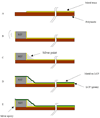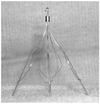Real-time 3-D ultrasound guidance of interventional devices
- PMID: 18986903
- PMCID: PMC2656286
- DOI: 10.1109/TUFFC.898
Real-time 3-D ultrasound guidance of interventional devices
Abstract
We have previously developed 2-D array transducers for many real-time volumetric imaging applications. These applications include transducers operating up to 7 MHz for transthoracic imaging, up to 15 MHz for intracardiac echocardiography (ICE), 5 MHz for transesophageal echocardiography (TEE) and intracranial imaging, and 7 MHz for laparoscopic ultrasound imaging (LUS). Now we have developed a new generation of miniature ring-array transducers integrated into the catheter deployment kits of interventional devices to enable real-time 3-D ultrasound scanning for improved guidance of minimally invasive procedures. We have constructed 3 new ring transducers. The first consists of 54 elements operating at 5 MHz. Typical measured transducer element bandwidth was 25%, and the 50 Ohm round trip insertion loss was -65 dB. Average nearest neighbor cross talk was -23.8 dB. The second is a prototype 108-element transducer operating at 5 MHz. The third is a prototype 108-element ring array with a transducer center frequency of 8.9 MHz and a -6 dB bandwidth of 25%. All transducers were integrated with an 8.5 French catheter sheath of a Cook Medical, Inc. vena cava filter deployment device.
Figures


 .
.
 .
.

 .
.
 .
.


 .
.
 .
.



 .
.
 .
.


Similar articles
-
New fabrication techniques for ring-array transducers for real-time 3D intravascular ultrasound.Ultrason Imaging. 2009 Oct;31(4):247-56. doi: 10.1177/016173460903100403. Ultrason Imaging. 2009. PMID: 20458877 Free PMC article.
-
Real-time 3D laparoscopic ultrasonography.Ultrason Imaging. 2005 Jul;27(3):129-44. doi: 10.1177/016173460502700301. Ultrason Imaging. 2005. PMID: 16550704
-
Ring array transducers for real-time 3-D imaging of an atrial septal occluder.Ultrasound Med Biol. 2012 Aug;38(8):1483-7. doi: 10.1016/j.ultrasmedbio.2012.03.019. Epub 2012 Jun 12. Ultrasound Med Biol. 2012. PMID: 22698504 Free PMC article.
-
Principles and devices.Semin Vasc Surg. 2006 Sep;19(3):128-31. doi: 10.1053/j.semvascsurg.2006.06.006. Semin Vasc Surg. 2006. PMID: 16996413 Review.
-
[Ultrasound-guided interventions and description of the equipment].Z Gastroenterol. 2010 Nov;48(11):1305-16. doi: 10.1055/s-0029-1245706. Epub 2010 Nov 1. Z Gastroenterol. 2010. PMID: 21043010 Review. German.
Cited by
-
New fabrication techniques for ring-array transducers for real-time 3D intravascular ultrasound.Ultrason Imaging. 2009 Oct;31(4):247-56. doi: 10.1177/016173460903100403. Ultrason Imaging. 2009. PMID: 20458877 Free PMC article.
-
Acoustic radiation force impulse imaging (ARFI) on an IVUS circular array.Ultrason Imaging. 2014 Apr;36(2):98-111. doi: 10.1177/0161734613511595. Ultrason Imaging. 2014. PMID: 24554291 Free PMC article.
-
2D array imaging system for mechanically-steered, forward-viewing ultrasound guidewire.Ultrasonics. 2024 Aug;142:107398. doi: 10.1016/j.ultras.2024.107398. Epub 2024 Jul 14. Ultrasonics. 2024. PMID: 39018696 Free PMC article.
-
An Investigation of Silica Aerogel to Reduce Acoustic Crosstalk in CMUT Arrays.Sensors (Basel). 2021 Feb 19;21(4):1459. doi: 10.3390/s21041459. Sensors (Basel). 2021. PMID: 33669794 Free PMC article.
-
Voltage-based device tracking in a 1.5 Tesla MRI during imaging: initial validation in swine models.Magn Reson Med. 2014 Mar;71(3):1197-209. doi: 10.1002/mrm.24742. Magn Reson Med. 2014. PMID: 23580479 Free PMC article.
References
-
- Smith SW, Trahey GE, von Ramm OT. Two-dimensional arrays for medical ultrasound. Ultrason. Imag. 1992;vol. 14(no 3):213–233. - PubMed
-
- Light ED, Davidsen RE, Hrushka TA, Smith SW. Progress in two-dimensional arrays for real time volumetric imaging. Ultrason. Imag. 1998;vol. 20(no 1):1–16. - PubMed
-
- Light ED, Fiering JO, Hultman PA, Lee W, Smith SW. Update of two dimensional arrays for real time volumetric and real time intracardiac imaging; Proc. IEEE Trans. Ultrasonics Symp; 1999. pp. 1217–1220.
-
- Light ED, Idriss SF, Wolf PD, Smith SW. Real time three dimensional intracardiac echocardiography. Ultrasound Med. Biol. 2001;vol. 27(no 9):1177–1183. - PubMed
-
- Lee W, Idriss SF, Wolf PD, Smith SW. A miniaturized catheter 2-D array for real-time 3D intracardiac echocardiography. IEEE Trans. Ultrason. Ferroelectr. Freq. Control. 2004;vol. 51(no 10):1334–1346. - PubMed
Publication types
MeSH terms
Grants and funding
LinkOut - more resources
Full Text Sources
Miscellaneous

